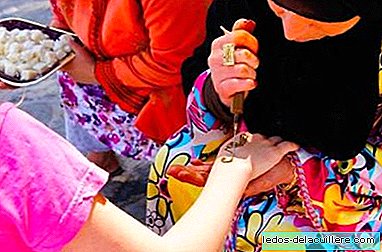
At this time we go out more often and especially the holiday places are filled with craft stands, braids and henna tattoos... Proposals often aimed at children, some of which could involve risks.
Pediatric Associations have drawn attention to The risks of black henna tattoos for children, temporary tattoos that are usually offered as safe for adults and children.
But in parallel to the increase in the dissemination of black henna tattoos, multiple cases of allergic contact eczema are appearing after its completion, many in children and adolescents. Let's look first at what these temporary tattoos consist of.
Black henna is not natural henna
Henna is a plant native to some regions of Africa, Asia and arid areas of Australia (its scientific name is Lawsonia inermis). It has been used since time immemorial to decorate the body, since its leaves, once they have been ground, produce a red tint. This type of decoration, known as "mehndi", is still used today in many parts of the world to decorate the skin at festivals and cultural celebrations.
But it is not exactly this natural dye that is used in our environment in the stalls and premises that offer temporary black henna tattoos. A leisure option (paid) that arises in summer in many vacation spots, markets, stores ... and that invite us to decorate our body with these tattoos that "do not prick" (they are not subcutaneous).
Through a look at several articles published in the journal Annals of Pediatrics we warn those risks, which come mainly from the fact that black henna contains paraphenylenediamine (PPD) in its composition, a synthetic dye whose main use is as a component of hair dyes, with great sensitizing power.
The association of PPD with henna aims to shorten the time of penetration and impregnation of the dye and increase the intensity of coloration. But being a product with such sensitizing power, its use is regulated in common cosmetic products.
In one of these studies we read that according to the regulations in force in the European Union on the composition of cosmetic products, PPD cannot be at a concentration greater than 6% and cannot be applied directly to the skin, eyebrows or eyelashes.
But while in the hair dyes other components (especially hydrogen peroxide) accelerate the oxidation of the PPD, degrading it and limiting its sensitizing capacity, in tattoos, this neutralization process does not exist, so the PPD is maintained directly in skin contact for several days.
Black henna tattoos They are not contemplated in the aforementioned regulations on cosmetics, placing themselves in a legislative vacuum that gives rise to the non-professional application, without control, of these tattoos, of which it is impossible to know the exact composition.

What reactions causes black henna in children?
Also the FDA in the United States has called attention to the possible dangers of these temporary tattoos, and a few years ago we talked about an impressive case in which the child, perhaps, will have the scar for life.
The cases reported over the last years of children affected by reaction to black henna tattoos They include redness, blisters, suppurating red lesions, loss of pigmentation, increased sensitivity to sunlight, and even permanent scars. The extreme case of more serious complication is the development of severe renal insufficiency due to glomerulonephritis caused by percutaneous absorption of PPD.
As you can imagine, the scare must have been tremendous in these families who had taken the tattoo as another fun of the summer. A diversion that was expensive, with a visit to the hospital included. The reactions can occur from a few hours after the tattoo is done weeks later, depending on the type and intensity of the reaction.
Recall that natural henna, which does not usually produce allergies, is a greenish-brown color and its mark on the skin is brown-red. Lasts on the skin three or four days.
Black henna is the one that can cause serious allergies, it is of intense black color, and its duration on the skin is more than a week. The problem is that in most posts black henna is applied because the temporary tattoo lasts longer.
Therefore, attention this summer to the street stalls they propose black henna tattoos for kidsWe have to be very sure that the product used does not carry large amounts of PPD and is really based on henna, a natural product rarely described as allergy cases.












